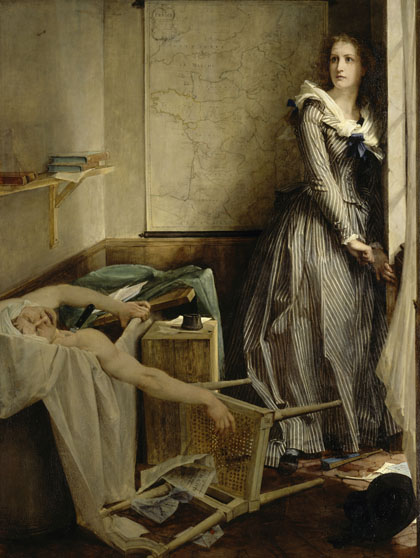Fr : version française / En: english version
mheu, Historical Museum of the Urban Environment
July 13, 1793: Murder of Marat by Charlotte Corday
Paul Baudry

1860
154cm x 203cm
oil on canvas
Nantes, Musée des Beaux-Arts
© RMN / Gérard Blot
View this work in the exhibition Bathing
The work
This version of the Assassination of Marat depicts Corday as a frightened, perhaps even dreamy young Virgin. Does she regret her action? Baudry has a map of France pinned to the wall against which she is leaning. What does it signify? Painted in 1860, in the middle of the Second Empire, this picture seeks above all to offend no-one. Charlotte Corday can be seen as the symbol of France as a victim of the Terror (hence the map), or as a poor irresponsible foolish young woman. Yet the painting is above all Baudry's tribute to David: it represents the same scene in an identical setting and with the same furniture (the wooden box used as a table, the board across the bathtub covered with a green cloth) but seen from another angle. Only the knife is different. And on this point Baudry is right: the police report mentions an ebony rather than an ivory handle.
The artist
Born into a humble family in La Roche-sur-Yon in 1828 (his father was a cobbler), Paul Baudry won a scholarship to study at the Beaux-Arts in Paris in 1844. He won the Prix de Rome in 1850 on his fifth attempt, (which he shared with Bouguereau). There would be nothing much to say about this Neoclassical artist, a lover of Raphael, Michelangelo and Italian Renaissance painting, had he not become one of the staunchest opponents of Manet and later Impressionism. His respectable academic career and the friendship of Napoleon III ought to have been enough. Although Emile Zola may have made him his whipping boy for a time, one must not forget that he was held in high esteem in his day. There was even talk of replacing the originals of Michelangelo and Raphael with his copies, considered excellent, for fear that they might be destroyed by the gaslights catching fire—an argument that hastened the installation of electric lighting where these precious works were hung.